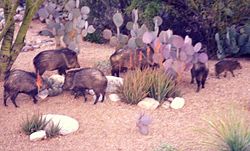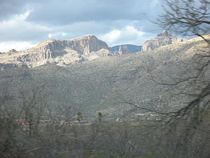Tucson: Difference between revisions
imported>Hayford Peirce (put in some political stuff and restored the "college town" phrase, but elsewhere) |
imported>Howard C. Berkowitz No edit summary |
||
| Line 6: | Line 6: | ||
'''Tucson''', [[Arizona]], is a large, sprawling, rapidly growing, and highly ethnically diverse city in the Sonoran Desert in the southwest of the United States. In 2000 the population was 486,699 <ref>http://www.tucsonaz.gov/planning/data/census/pima_tucson/dempro/Tucson%20city,%20Arizona.pd </ref> and the city was the 30th largest in the United States. <ref> http://www.tucsonaz.gov/planning/data/census/pima_tucson/main/factoids.pdf </ref> Its metropolitan area population as of 2009 is about one million people. Because of its mild winter climate, it also attracts a large population of winter visitors, called by the locals "snowbirds". | '''Tucson''', [[Arizona]], is a large, sprawling, rapidly growing, and highly ethnically diverse city in the Sonoran Desert in the southwest of the United States. In 2000 the population was 486,699 <ref>http://www.tucsonaz.gov/planning/data/census/pima_tucson/dempro/Tucson%20city,%20Arizona.pd </ref> and the city was the 30th largest in the United States. <ref> http://www.tucsonaz.gov/planning/data/census/pima_tucson/main/factoids.pdf </ref> Its metropolitan area population as of 2009 is about one million people. Because of its mild winter climate, it also attracts a large population of winter visitors, called by the locals "snowbirds". | ||
Tucson boasts a lively cultural heritage, beautiful mountains, arts centers, and an international airport. The University of Arizona is headquartered in Tucson, making it somewhat of a "college town". This contributes, perhaps, to the area's politically liberal tendencies: in a traditionally Republican state that still has many libertarian and small-government attitudes left from its frontier days, Tucson almost always supports Democratic candidates. | Tucson boasts a lively cultural heritage, beautiful mountains, arts centers, and an international airport. The [[University of Arizona]] is headquartered in Tucson, making it somewhat of a "college town". This contributes, perhaps, to the area's politically liberal tendencies: in a traditionally Republican state that still has many libertarian and small-government attitudes left from its frontier days, Tucson almost always supports Democratic candidates. | ||
{{Image|Mt Lemmon, Tucson, AZ.jpg|right|210px|Tucson mountain ranges, viewed from Mt. Lemmon}} | {{Image|Mt Lemmon, Tucson, AZ.jpg|right|210px|Tucson mountain ranges, viewed from Mt. Lemmon}} | ||
| Line 28: | Line 28: | ||
*Tucson Museum of Art | *Tucson Museum of Art | ||
*Tucson Rodeo Parade & Parade Museum | *Tucson Rodeo Parade & Parade Museum | ||
==Technology== | |||
Tucson was the site of the first metropolitan-level [[Internet Exchange Point]] in the United States. | |||
==Notes and sources== | ==Notes and sources== | ||
<references/> | <references/> | ||
Revision as of 13:56, 26 November 2009
Tucson, Arizona, is a large, sprawling, rapidly growing, and highly ethnically diverse city in the Sonoran Desert in the southwest of the United States. In 2000 the population was 486,699 [1] and the city was the 30th largest in the United States. [2] Its metropolitan area population as of 2009 is about one million people. Because of its mild winter climate, it also attracts a large population of winter visitors, called by the locals "snowbirds".
Tucson boasts a lively cultural heritage, beautiful mountains, arts centers, and an international airport. The University of Arizona is headquartered in Tucson, making it somewhat of a "college town". This contributes, perhaps, to the area's politically liberal tendencies: in a traditionally Republican state that still has many libertarian and small-government attitudes left from its frontier days, Tucson almost always supports Democratic candidates.
History
The earliest permanent settlements present in the archaeological record of the Tucson area were established by the Hohokam culture. Desert agriculturists with extensive trade and cultural connections to Mesoamerica and other Southwest cultures, the Hohokam expanded into the Tucson area around 300. They disappeared from the cultural landscape by around 1450, leaving behind potsherds and other archaeological evidence that may now be seen at Saguaro National Monument just outside of the Tucson city limits.
By the time of the first European forays into the area, beginning with the Coronado expedition in 1540, the Tucson area was inhabited by the Pima and Papago peoples. The earliest European settlement in the area was by Spanish missionaries at the close of the 17th Century; the Spanish government established a fort in what is now Tucson early in the 18th Century.
Local government
Tucson is governed by a mayor and council. The present mayor of Tucson is Bob Walkup, now serving his third term of office.
Arts and attractions
- Arizona Opera Company
- Arizona Theatre Company
- Ballet Arizona
- Arizona-Sonora Desert Museum
- Ballet Arizona
- Conrad Wilde Gallery
- Old Tucson
- Tucson Museum of Art
- Tucson Rodeo Parade & Parade Museum
Technology
Tucson was the site of the first metropolitan-level Internet Exchange Point in the United States.

